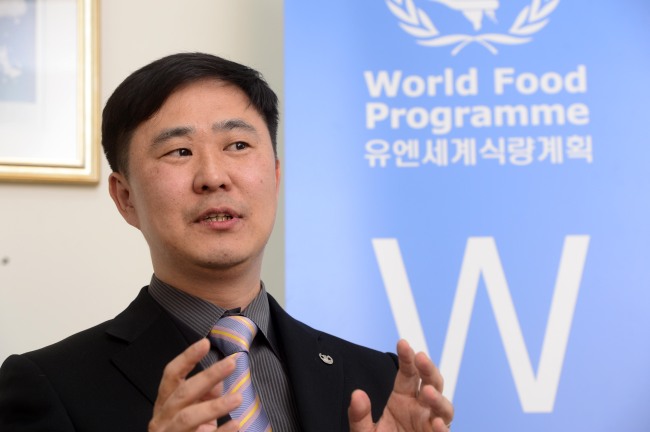This is the third installment in a series interviews with chiefs of United Nations offices in Korea. ― Ed.
Feeling empty and lost, university student Lim Hyoung-joon started backpacking around the world in 1990 in search of inspiration for a worthy life.
After roaming every corner of the globe from affluent metropolises of the U.S. to poverty-stricken streets in Bangladesh, he went to Malawi in 1994.
Three days in the African country changed his life. With no other means of payment than traveler’s checks, which were not cashable there, he had to survive on his sugarcane walking stick. Experiencing the pain of hunger in such an extreme way, Lim landed in a small town and watched workers from the U.N. World Food Program dole out food to villagers who were delighted as if they were the most blessed on the planet.
“At that moment I got the answer that I’d been seeking for four years ― this is what I’m supposed to do, even though I had absolutely no idea what the U.N. was,” said Lim, who is now 43 and heads the Seoul office of the world’s largest humanitarian agency.
 |
Lim Hyoung-joon, head of the U.N. World Food Program’s Korea office. (Park Hae-mook/The Korea Herald) |
Lim joined the WFP in 2002 through a junior professional officer program after an internship at the U.N. headquarters in New York and the U.N. Development Program in Albania. He has since worked in such countries as Honduras, Guinea-Bissau and Laos before coming to Seoul in November 2011.
While still feeling “most alive” out in the field, Lim sees so much to give back from here, he says, stressing Korea’s ascent from an aid recipient to a provider.
From 1964-84, the Rome-based organization funneled more than $102 million into 23 projects across the country for purposes such as flood control, road construction and land reclamation, providing the second-largest aid to Korea among U.N. bodies behind the U.N. Korean Reconstruction Agency, an economic rehabilitation program launched in the aftermath of the 1950-53 Korean War.
As a new donor nation, Seoul currently works together with the WFP to fight hunger and poverty in the underdeveloped world. They conducted pilot programs to share Korea’s successful Saemaul Movement, an agricultural and rural reform drive in the 1970-80s, in Rwanda and Nepal in 2011 and Tanzania and Bangladesh in 2013.
The “Food for New Village” projects could be a crucial tool for the “Zero Hunger” initiative unveiled by U.N. Secretary-General Ban Ki-moon at a conference in Rio de Janeiro in 2012, Lim said.
“The Saemaul Movement may bring synergy for our Zero Hunger campaign as it includes programs that could actually help these countries graduate from poverty, such as for nurturing rural leaders and boosting community income,” he said.
“We’re now hoping to scale up the programs to a sizeable level.”
Despite Seoul’s achievements, Lim added to growing calls for greater commitment toward supporting the developing world. The rising portion of loans, rather than grants, in its official development assistance remains another concern.
The WFP is also known for its operations in North Korea, aimed at fighting hunger and malnutrition among women and children. It also provides rare statistics on food rations and grain production there.
But the agency has been struggling to raise funds in recent years in the face of global sentiment dampened by the communist regime’s persistent nuclear development and other provocations.
The shriveled contributions brought the WFP’s food aid to the poverty-stricken nation to an all-time low in 2013 with some 38,000 tons. That was less than one-third of its target of 130,000 tons.
The organization said in January it would need about $200 million to provide nutritional support to some 2.4 million North Koreans until mid-2015 but had collected only $18.5 million as of January.
“We simply need more support,” Lim said. “We’re not getting 10 percent of what we should have.”
To raise public awareness and court more patrons here, the WFP Korea has forged partnerships with other institutions, state agencies, businesses and nongovernmental groups.
Its office moved onto the campus of Seoul National University after it clinched an agreement in December 2012 to expand cooperation. Lim often gives lectures there and at other universities and organizations.
LG Electronics supported education and poverty eradication in countries including Kenya, Ethiopia, Bangladesh and Cambodia as part of its “Hope Village” and “Hope Family” programs with the WFP between 2009 and 2013. Top actor Jang Dong-gun has been its goodwill ambassador since 2008.
“While strengthening public relations, we’re currently trying to concentrate our capacity on our work with the government here since our operations are still in their infancy,” Lim said.
“Just like Korea escaped famine itself, it can play a role in helping another 840 million people follow suit. … Eradicating extreme poverty is the most pivotal foundation for development.”
By Shin Hyon-hee (
heeshin@heraldcorp.com)







![[Weekender] Korea's traditional sauce culture gains global recognition](http://res.heraldm.com/phpwas/restmb_idxmake.php?idx=644&simg=/content/image/2024/11/21/20241121050153_0.jpg)
